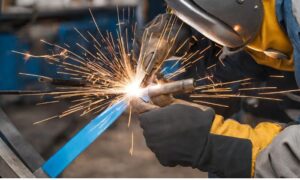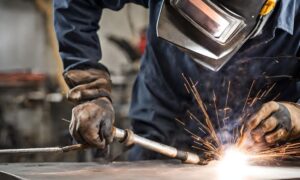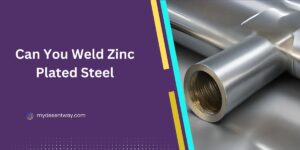Table of Contents
You might want to learn how to weld but don’t have a tool on hand. Do not worry! In this detailed guide, we will look at some creative ways that you can learn to weld without a normal welding machine. Some of the ways you will learn how to weld without a welder are cheap and use things you already have. Now is the time to start getting you excited about welding!
1. Recognizing Welding and Its Tools
Welding typically employs a welder, a machine that generates intense heat to melt metal, allowing it to join two pieces together. The process demands skill, precision, and proper safety measures. Professionals and hobbyists often rely on welders to fabricate structures, repair machinery, or create artistic metalwork.
Limitations of Not Having a Welder
For many DIY enthusiasts or individuals lacking access to welding equipment, the inability to weld might seem limiting. However, this obstacle has prompted the exploration of alternative methods to achieve similar outcomes without traditional welding tools. These alternative techniques, while differing from conventional welding, offer unique approaches to bonding materials together effectively.
Welding without a welder doesn’t necessarily mean compromising on strength or quality. Instead, it encourages innovation, exploring various methods that suit different materials and purposes. From adhesive bonding to specialized techniques like brazing and soldering, there is a spectrum of options to explore when traditional welding tools aren’t available.
2. Types of Welding Techniques
1. Adhesive Bonding
Adhesive bonding stands as one of the simplest yet most effective methods for joining materials without a welder. This technique involves using powerful adhesives to create strong bonds between surfaces. Various types of adhesives, such as epoxies and cyanoacrylates (commonly known as super glue), offer different properties suitable for diverse materials.
Adhesive bonding requires proper surface preparation, ensuring that the surfaces to be bonded are clean, dry, and free from contaminants. The application of the adhesive must be precise, followed by clamping or applying pressure to hold the materials together until the adhesive sets completely.
2. Brazing
Brazing involves joining metals by melting a filler metal and flowing it into the joint, typically at lower temperatures than traditional welding. This technique requires the use of a filler metal, usually an alloy with a lower melting point than the base metals being joined. Flux, a chemical cleaning agent, is also used to prevent oxidation and promote bonding.
The process begins with cleaning and preparing the surfaces to be joined, followed by heating the base metals and applying the filler metal to create the joint. Once the joint cools, a strong bond forms between the materials.
3. Soldering
Soldering is a technique commonly used for electronics and smaller metalwork. It involves melting a filler material, known as solder, at relatively low temperatures to join materials together. Solder typically contains a mix of metals like tin and lead or other alloys.
Similar to brazing, soldering requires clean surfaces and the application of flux to ensure a strong bond. Heating the joint and applying the molten solder creates the connection, which solidifies upon cooling, forming a reliable bond.
4. Cold Welding
Unlike traditional welding, which uses heat, cold welding joins metals together through pressure. This method is suitable for sensitive materials that can’t withstand high temperatures. Cold welding relies on applying force to create a solid connection between materials.
The surfaces to be joined need to be meticulously cleaned to remove any impurities. Applying pressure using specialized tools or techniques ensures that the materials bond securely without the need for heat.
Each of these techniques offers unique advantages and applications, providing viable alternatives when a welder isn’t accessible. From the simplicity of adhesive bonding to the strength of brazing and the precision of soldering, these methods cater to various needs and materials, enabling individuals to achieve robust bonds without traditional welding equipment.
3. Materials Required
Adhesive Bonding
- Adhesives: Different types of adhesives, such as epoxy, cyanoacrylate (super glue), or polyurethane adhesives, are suitable for various materials.
- Cleaners: Solvents or cleaners to prepare surfaces before bonding.
- Clamps or Pressure Application Tools: Essential for holding materials together while the adhesive sets.
Brazing
- Filler Metals: Alloys compatible with the base metals being joined, typically containing elements like brass, silver, or aluminum.
- Flux: Chemical cleaning agents to prevent oxidation and promote bonding.
- Torch or Heat Source: Propane, oxy-acetylene torch, or other heating tools to melt the filler metal.
Soldering
- Solder: Composed of tin, lead, or lead-free alloys with a lower melting point.
- Flux: To clean and prepare surfaces for soldering.
- Soldering iron or torch: Heat source for melting the solder and joining materials.
Cold Welding
- Cleaning Materials: Solvents or cleaning agents are used to prepare surfaces.
- Pressure Application Tools: Devices or methods to apply pressure to join materials without heat.
- Compatible Materials: Metals suitable for cold welding, such as certain alloys or sensitive materials.
The materials for each technique are critical for successful bonding. Choosing the right adhesive, filler metal, solder, or pressure application tools depends on the materials being joined and the specific requirements of the project. Proper surface preparation is essential for all methods to ensure strong and durable bonds.
4. Step-by-Step Guide for Each Technique
Adhesive Bonding
Surface Preparation:
- Clean the surfaces thoroughly with appropriate solvents or cleaners to remove any dirt, oil, or debris.
- Ensure the surfaces are dry before applying the adhesive.
Adhesive Application:
- Apply the adhesive evenly to one of the surfaces to be bonded.
- Press the surfaces together firmly, ensuring proper alignment.
Clamping or Pressure Application:
- Use clamps or pressure application tools to hold the materials together as per the adhesive instructions.
- Allow sufficient time for the adhesive to set and cure based on the manufacturer’s guidelines.
Brazing
Surface Preparation:
- Clean the surfaces to be joined thoroughly to remove any contaminants.
- Apply flux to prevent oxidation during the heating process.
Heating and Filler Metal Application:
- Heat the base metals using a torch or other heating tools.
- Once the metals reach the appropriate temperature, apply the filler metal to the joint, allowing it to flow and create the bond.
Cooling and solidification:
- Allow the joint to cool naturally, ensuring a strong bond forms between the metals.
- Clean the joint to remove any residual flux.
Soldering
Surface Preparation:
- Clean the surfaces and apply flux to prepare for soldering.
Heating and Solder Application:
- Heat the joint using a soldering iron or torch.
- Apply the molten solder to the joint, ensuring it flows evenly and forms a strong bond.
Cooling and solidification:
- Allow the solder joint to cool and solidify completely before handling.
Cold Welding
Surface Preparation:
- Clean the surfaces meticulously to ensure no contaminants are present.
Pressure Application:
- Apply pressure using specialized tools or techniques to join the materials together securely.
- Ensure a tight and uniform application of pressure across the joint.
Time for bonding:
Allow sufficient time for the materials to bond under pressure, ensuring a strong connection is established.
Each step in these techniques is crucial for achieving successful bonding without a welder. Following these detailed instructions, from surface preparation to the application of materials and allowing for proper bonding time, ensures that individuals can effectively join materials using these alternative welding methods. Understanding and executing these steps accurately will lead to strong and durable bonds without the need for traditional welding equipment.
5. Safety Precautions
General Safety Measures
- Protective Gear: Wear appropriate personal protective equipment (PPE) such as gloves, safety goggles, and a face mask to shield against fumes and potential splatters.
- Ventilation: Work in a well-ventilated area or use exhaust systems to minimize exposure to fumes and gases generated during the bonding process.
Adhesive Bonding Safety
- Handling Adhesives: Follow the manufacturer’s guidelines for handling adhesives and ensure proper ventilation when using strong adhesives.
- Avoiding Skin Contact: Prevent skin contact with adhesives by using gloves, and immediately clean any accidental spills.
Brazing and Soldering Safety
- Heat Protection: Use heat-resistant gloves and clothing to protect against burns when working with torches or soldering irons.
- Flux Safety: Be cautious while handling flux, as some types can be irritants; use in a well-ventilated area and avoid inhaling fumes.
Cold Welding Safety
- Pressure Application: Follow safety guidelines when applying pressure; ensure tools are used correctly to prevent accidents.
- Material Compatibility: Understand the materials suitable for cold welding to avoid any potential hazards due to incompatible materials.
Workspace Safety
- Workspace Preparation: Clear the work area of clutter to prevent accidents and ensure a stable work surface for handling materials.
- Fire Safety: Have a fire extinguisher nearby, especially when working with heat sources like torches, to handle any unexpected fires.
Post-Bonding Safety
- Cooling Period: Allow adequate time for materials to cool down before handling to prevent burns or accidental damage to the bond.
- Cleaning Up: Properly dispose of any used materials or clean surfaces to avoid accidental contact or contamination.
Adhering to these safety precautions is paramount when welding without a welder. By prioritizing safety, individuals can minimize risks and ensure a secure working environment while using alternative welding techniques.
Taking necessary precautions not only safeguards against immediate hazards but also promotes a safer and more enjoyable welding experience overall. Safety remains a top priority in all aspects of welding, regardless of the method used.
6. Pros and Cons of Welding Without a Welder
Adhesive Bonding
Pros:
- Simplicity: Adhesive bonding is straightforward, making it accessible for beginners.
- No Heat Required: No need for high temperatures, reducing the risk of damage to sensitive materials.
Cons:
- Strength Limitations: While strong, adhesive bonds may not match the strength of traditional welds.
- Surface Dependence: The effectiveness depends on the surfaces being bonded, which are not suitable for all materials.
Brazing
Pros:
- Strong Joints: Brazing creates robust joints, often stronger than adhesive bonds.
- Versatility: Suitable for various metals and alloys.
Cons:
- Heat Required: Brazing involves heating, which may not be ideal for temperature-sensitive materials.
- Skill Requirement: Requires some skill and experience to achieve optimal results.
Soldering
Pros:
- Low Heat: Soldering uses lower temperatures, preventing damage to delicate materials.
- Electronics Applications: Ideal for joining electrical components and delicate metals.
Cons:
- Limited Strength: Soldered joints may not be as strong as other welding methods.
- Skill Sensitivity: Requires precision and skill, especially for intricate work.
Cold Welding
Pros:
- No Heat Required: Ideal for materials sensitive to high temperatures.
- Pressure Bonding: Creates strong bonds without the need for heat.
Cons:
- Material Limitations: Limited to certain materials and may not be suitable for all applications.
- Pressure Application: Requires careful application of pressure, and tools may be needed.
Understanding the pros and cons of each welding alternative is crucial for choosing the right method for a specific project. While these techniques offer versatility and accessibility, they also have limitations. Consideration of material compatibility, strength requirements, and skill level is essential to achieving successful results when welding without a traditional welder.
7. Applications and Projects
Adhesive Bonding
- Household Repairs: Ideal for fixing broken ceramics, plastic items, or wood furniture.
- Crafts and Decor: Use adhesive bonding for creating art projects, assembling models, or crafting decor items.
Brazing
- Metal Fabrication: Suitable for joining metals in automotive or bicycle repairs.
- Plumbing and HVAC: Brazing finds application in plumbing and HVAC systems for joining copper pipes and fittings.
Soldering
- Electronics: Used extensively for soldering electronic components on circuit boards.
- Jewelry Making: Ideal for crafting intricate jewelry pieces using delicate metals.
Cold Welding
- Sensitive Materials: Cold welding is useful for joining materials that can’t withstand high temperatures, like certain alloys or plastics.
- Laboratory Equipment: Used in scientific settings to bond delicate instruments or laboratory equipment.
Each welding alternative finds its niche in specific applications and projects. From household repairs to specialized tasks in industries like automotive, electronics, and crafts, these methods offer flexibility and practicality when traditional welding tools aren’t available or suitable.
Understanding their applications empowers individuals to tackle diverse projects creatively and effectively. The versatility of these welding alternatives extends their use beyond industrial settings, making them accessible for DIY enthusiasts and professionals alike.
Conclusion
Welding without a welder unveils a spectrum of alternative techniques, each offering unique benefits and applications. From the simplicity of adhesive bonding to the strength of brazing and soldering and the versatility of cold welding, these methods provide viable options when traditional welding equipment isn’t accessible or suitable.
Benefits of Welding Alternatives
- Accessibility: These techniques are accessible to beginners and DIY enthusiasts, requiring minimal specialized equipment.
- Versatility: They cater to various materials and applications, from household repairs to industrial projects.
- Safety: Some methods, like adhesive bonding and cold welding, eliminate the need for high heat, making them safer for delicate materials.
Encouragement for Exploration
Exploring these welding alternatives encourages creativity and problem-solving. Understanding the intricacies of each method enables individuals to adapt and innovate in diverse projects. Moreover, it fosters a deeper appreciation for the art and science of joining materials, showcasing that effective welding doesn’t solely rely on traditional tools but on understanding the materials and techniques involved.
Final Note
While these welding alternatives offer practical solutions, they might not entirely replace traditional welding for certain applications that demand higher strength or specific metallurgical properties. However, they stand as invaluable options, particularly for small-scale repairs, crafts, and scenarios where traditional welding tools might not be accessible or suitable.
Exploration and experimentation with these techniques not only broaden skill sets but also foster a sense of resourcefulness and innovation. Embracing these alternative methods opens doors to creativity and problem-solving, ensuring that limitations like the absence of a welder don’t hinder the realization of projects or repairs.
FAQs about How to Weld Without a Welder
What are some alternatives to welding?
There are several alternatives to welding, including forge welding, brazing, soldering, adhesive bonding, mechanical fastening, cold welding, magnetic pulse welding, friction stir welding, ultrasonic welding, and laser welding.
Can I weld without a welder at home?
Yes, you can! Alternative methods like adhesive bonding, brazing, soldering, or cold welding offer feasible options for welding at home.
Do I need special skills to weld without a welder?
Basic skills and understanding are helpful, but these methods are accessible for beginners and DIY enthusiasts.
Are safety precautions necessary for welding without a welder?
Absolutely! Safety gear and precautions are crucial, ensuring protection from fumes and ensuring a safe working environment.













7 thoughts on “How to Weld Without a Welder: Alternative to Welding”